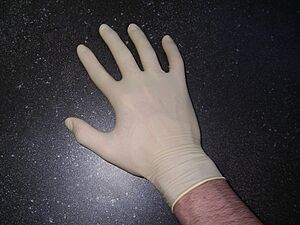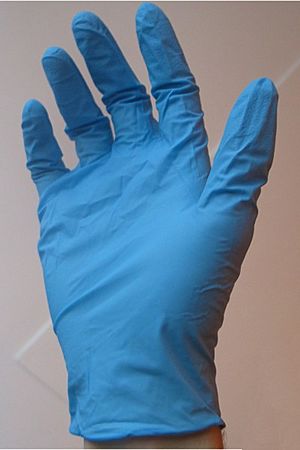Rubber glove facts for kids

A rubber glove is a special kind of glove made from a stretchy, waterproof material called rubber. This rubber can come from nature (like from rubber trees) or be made by people (synthetic rubber). Rubber gloves are great because they protect your hands from water, dirt, and even some chemicals. They can be just rubber, or they can have a fabric lining inside for extra comfort. People use them for many jobs, like washing dishes, cleaning, or working with certain materials.
Contents
How Rubber Gloves Started
Rubber gloves have been around for a long time! In 1894, a doctor named William Stewart Halsted worked at Johns Hopkins Hospital. He noticed that the chemicals used in surgery were hurting the hands of his wife, Caroline Hampton, who was also a nurse. To help her and other medical staff, he came up with the idea of using rubber gloves. This helped protect their hands from harsh chemicals. Later, in 1965, the first modern disposable gloves were created by a company called Ansell Rubber.
Gloves for Home and Work
Since the 1960s, people have been using rubber gloves at home for cleaning and washing dishes. You can find them in many colors and styles, but yellow and pink ones with long cuffs are very common. Gloves come in different lengths too, from short ones that cover your wrist to long ones that go up to your shoulder!
It's best to wear gloves that fit snugly but still let your hands move easily. Many gloves have a bumpy pattern on the palms and fingers. This helps you get a good grip on things, even when they are wet or soapy. Wearing gloves keeps your hands safe from strong cleaning products and hot water.
These gloves are popular for cleaning at home and are also used by professional cleaners. They are great for any job where your hands might get wet or dirty, like vacuuming, dusting, or polishing.
Most household gloves are made from latex, which is a type of natural rubber. They often have a soft cotton lining inside, called "flock," which makes them easier to put on and take off. Some people can have an allergic reaction to latex. Also, latex gloves might not protect well against certain chemicals called solvents. Because of this, gloves are also made from other materials like PVC, nitrile, or neoprene. Some natural rubber is specially treated to reduce allergens, so more people can use them safely.
In places where food is prepared, like restaurants, workers often wear gloves to keep food clean. They usually wash their hands first, then put on single-use gloves. Since some people are allergic to latex, many places use vinyl or nitrile gloves instead. Poly gloves are another very cheap option. These disposable gloves often come with or without a light powder inside (made from cornstarch) to help put them on. Most disposable gloves are made in countries like China, Malaysia, Indonesia, and Vietnam.
Gloves and Fingerprints
Sometimes, people wear gloves to avoid leaving their fingerprints on things. However, if the gloves are very thin, your fingerprints can sometimes still show through, leaving what are called "glove prints." Also, your own fingerprints can be left on the inside of the glove itself. Scientists can sometimes find these prints on gloves left behind. They can even figure out if the person who wore the glove was male or female from a glove print!
Important Safety Lessons
It's very important to choose the right type of glove for the job, especially when working with chemicals. In 1997, a scientist named Karen Wetterhahn had a serious accident. A few drops of a very dangerous chemical called dimethylmercury landed on her latex glove. Tests later showed that this chemical could quickly go through latex gloves and get onto the skin in about 15 seconds.
This sad event taught everyone a big lesson about how important it is to know if gloves can really protect you from certain chemicals. Now, scientists know that for very dangerous chemicals like dimethylmercury, special plastic-lined gloves are needed. This has led to much better safety rules in laboratories everywhere.
See also
- Glove
- Medical glove
- Finger cot
- Latex allergy


